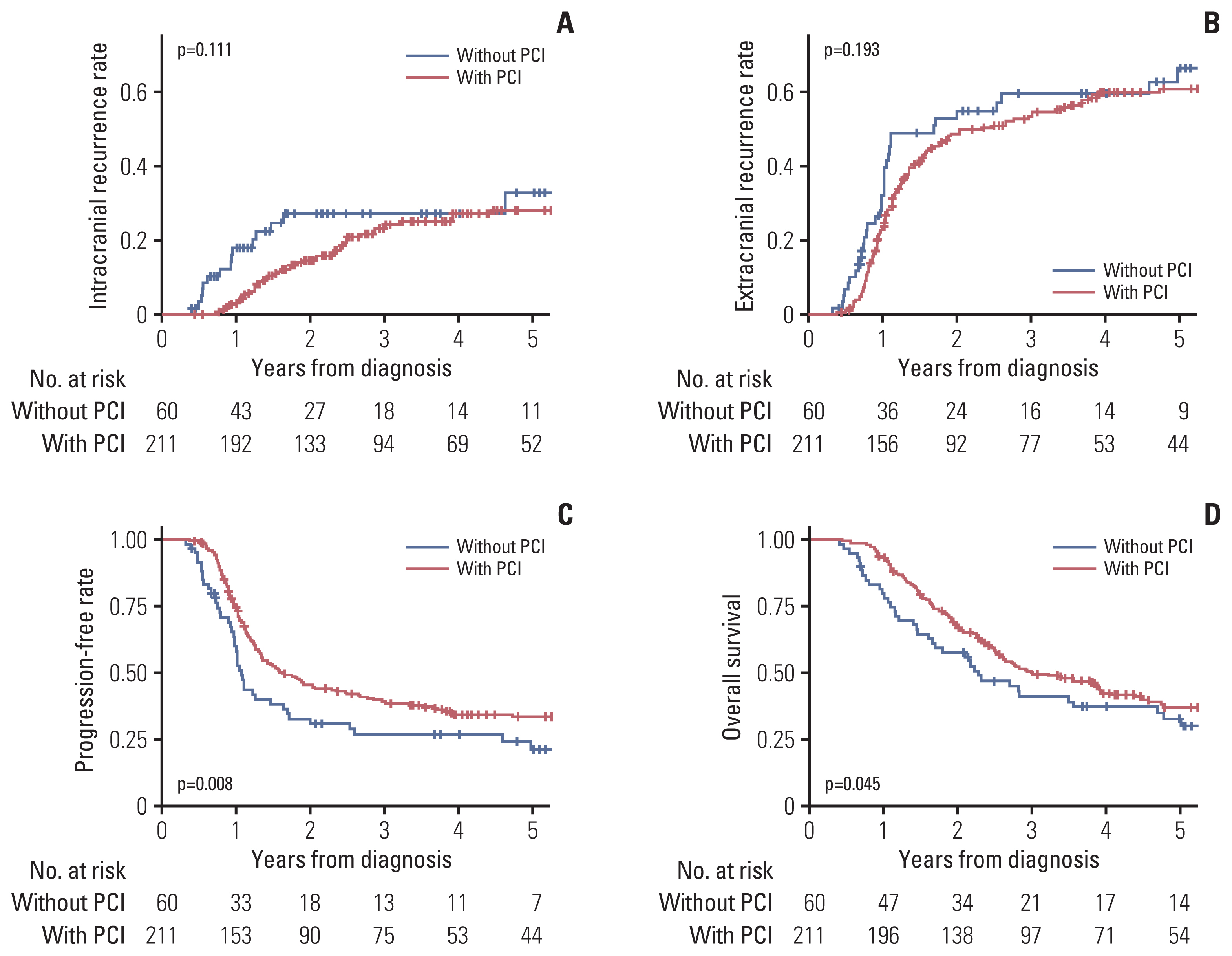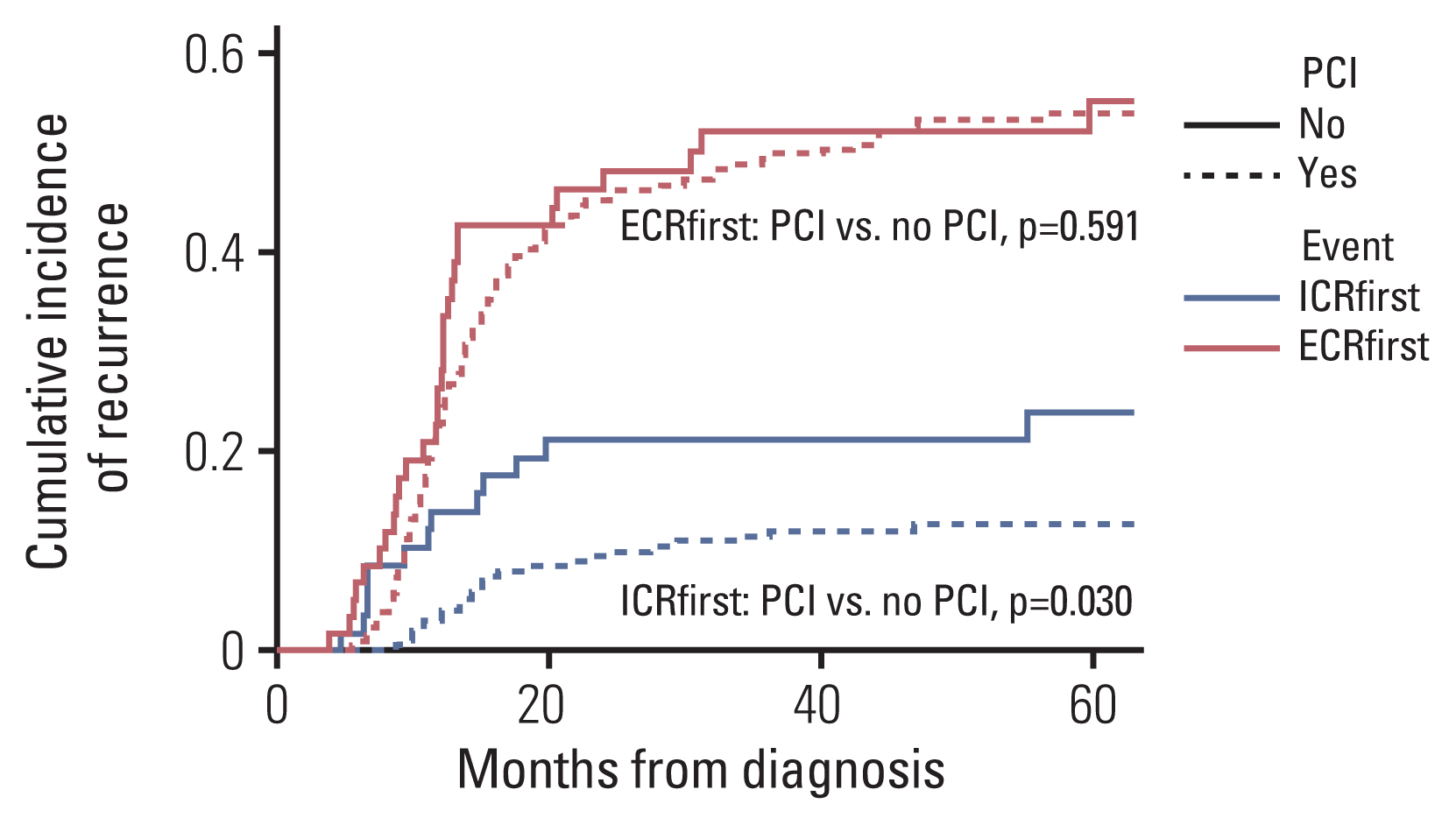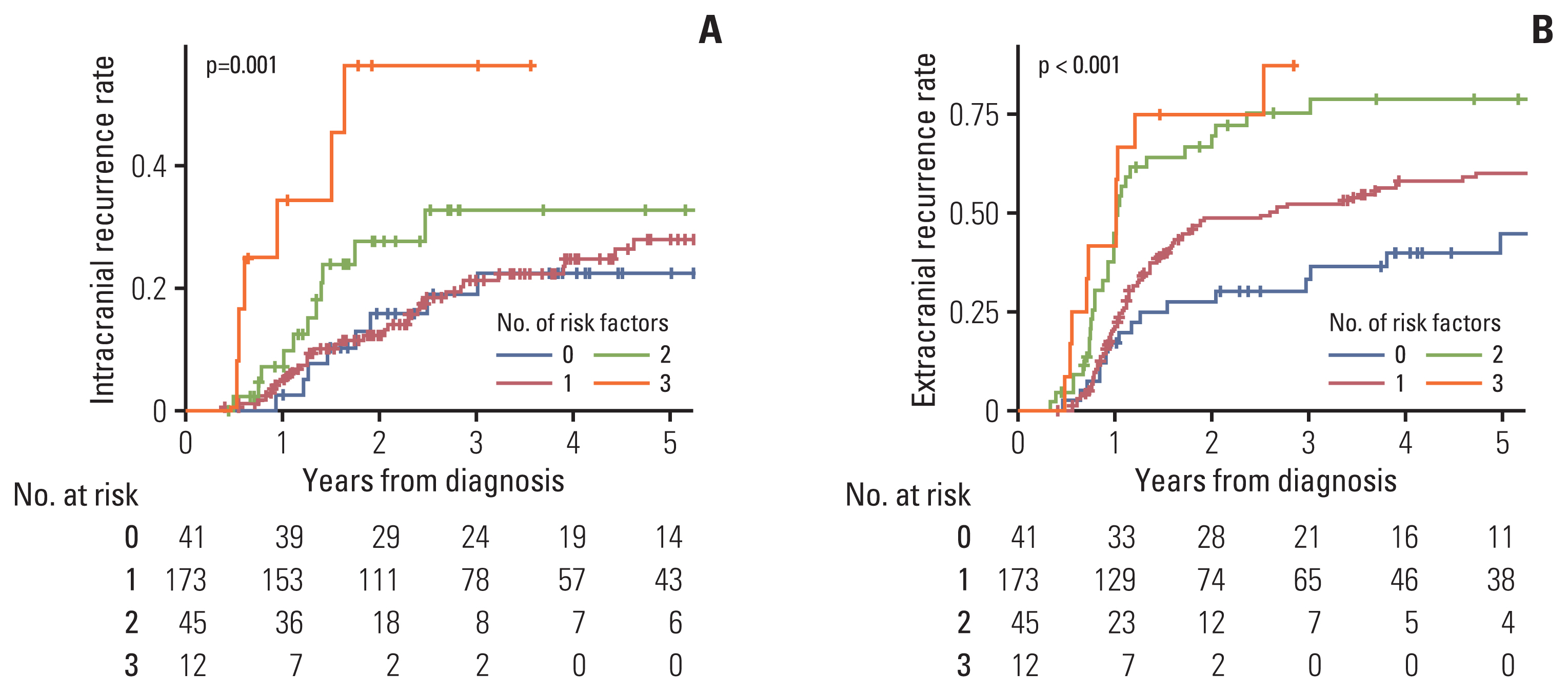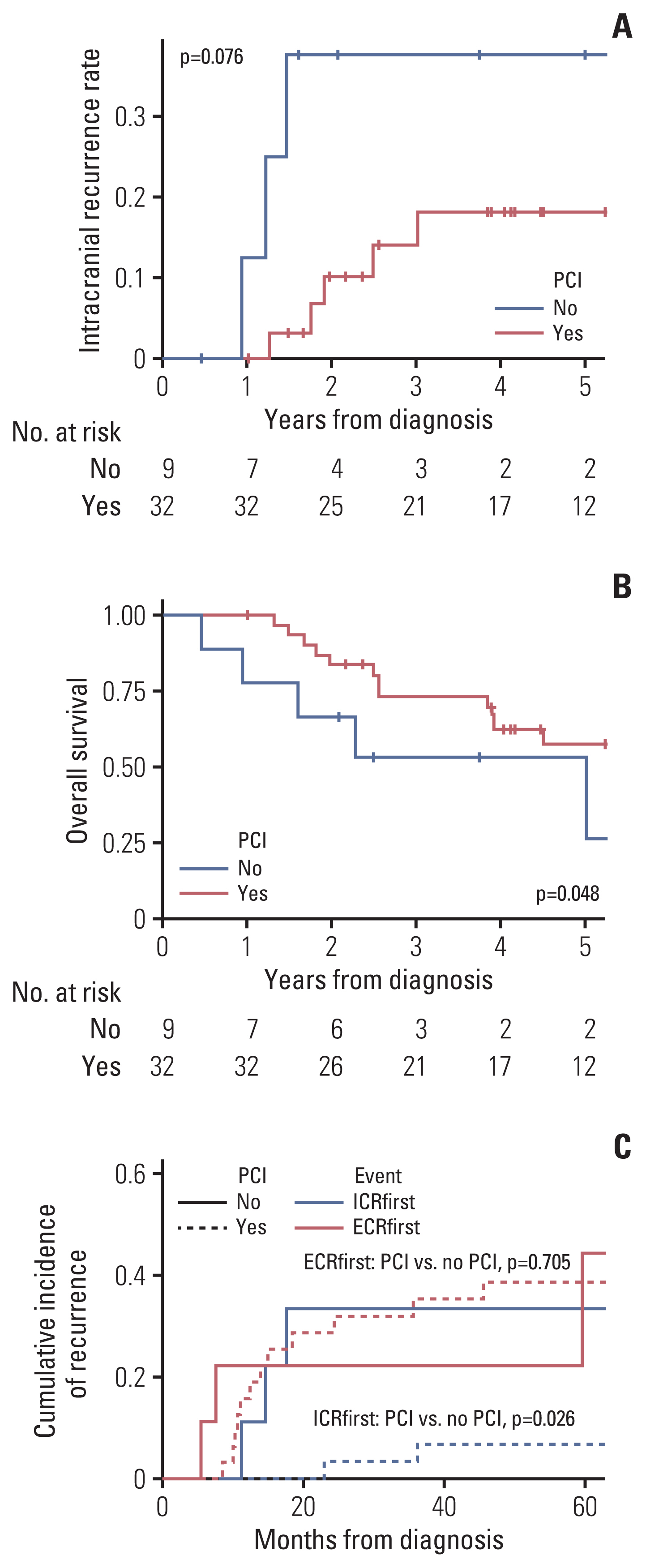Cancer Res Treat.
2023 Jul;55(3):875-884. 10.4143/crt.2022.1583.
Efficacy of Prophylactic Cranial Irradiation According to the Risk of Extracranial Recurrence in Limited-Stage Small Cell Lung Cancer
- Affiliations
-
- 1Department of Radiation Oncology, Seoul National University Hospital, Seoul, Korea
- 2Department of Radiation Oncology, Seoul National University College of Medicine, Seoul, Korea
- 3Cancer Research Institute, Seoul National University College of Medicine, Seoul, Korea
- 4Department of Radiation Oncology, Seoul Metropolitan Government-Seoul National University Boramae Medical Center, Seoul, Korea
- 5Department of Internal Medicine, Seoul National University Hospital, Seoul, Korea
- 6Department of Internal Medicine, Seoul Metropolitan Government-Seoul National University Boramae Medical Center, Seoul, Korea
- KMID: 2544168
- DOI: http://doi.org/10.4143/crt.2022.1583
Abstract
- Purpose
We aimed to evaluate the effectiveness of prophylactic cranial irradiation (PCI) for “early brain metastasis”, which occurs before extracranial recurrence (ECR), and “late brain metastasis”, which occurs after ECR, in limited-stage small cell lung cancer (LS-SCLC).
Materials and Methods
We retrospectively analyzed 271 LS-SCLC patients who underwent definitive chemoradiation. All patients were initially staged with brain magnetic resonance imaging and positron emission tomography. Intracranial recurrence (ICR), ECR, progression-free rate (PFR), and overall survival (OS) were analyzed as clinical endpoints. The competing risk of the first recurrence with ICR (ICRfirst) was evaluated. Significantly associated variables in multivariate analysis of ECR were considered as ECR risk factors. Patients were stratified according to the number of ECR risk factors.
Results
The application of PCI was associated with higher PFR (p=0.008) and OS (p=0.045). However, PCI was not associated with any of the clinical endpoints in multivariate analysis. The competing risk of ICRfirst was significantly decreased with the application of PCI (hazard ratio, 0.476; 95% confidence interval, 0.243 to 0.931; p=0.030). Stage III disease, sequential, and stable disease after thoracic radiation were selected as ECR risk factors. For patients without these risk factors, the application of PCI was significantly associated with increased OS (p=0.048) and a decreased risk of ICRfirst (p=0.026).
Conclusion
PCI may play a role in preventing early brain metastasis rather than late brain metastasis after ECR, suggesting that only patients with a low risk of ECR may currently benefit from PCI.
Keyword
Figure
Reference
-
References
1. Choi CM, Kim HC, Jung CY, Cho DG, Jeon JH, Lee JE, et al. Report of the Korean Association of Lung Cancer Registry (KALC-R), 2014. Cancer Res Treat. 2019; 51:1400–10.2. Edelman MJ. Prophylactic cranial irradiation for small-cell lung cancer: time for a reassessment. Am Soc Clin Oncol Educ Book. 2020; 40:24–8.3. Auperin A, Arriagada R, Pignon JP, Le Pechoux C, Gregor A, Stephens RJ, et al. Prophylactic cranial irradiation for patients with small-cell lung cancer in complete remission. Prophylactic Cranial Irradiation Overview Collaborative Group. N Engl J Med. 1999; 341:476–84.4. Hochstenbag MM, Twijnstra A, Wilmink JT, Wouters EF, ten Velde GP. Asymptomatic brain metastases (BM) in small cell lung cancer (SCLC): MR-imaging is useful at initial diagnosis. J Neurooncol. 2000; 48:243–8.5. Slotman BJ, Mauer ME, Bottomley A, Faivre-Finn C, Kramer GW, Rankin EM, et al. Prophylactic cranial irradiation in extensive disease small-cell lung cancer: short-term health-related quality of life and patient reported symptoms: results of an international Phase III randomized controlled trial by the EORTC Radiation Oncology and Lung Cancer Groups. J Clin Oncol. 2009; 27:78–84.
Article6. Takahashi T, Yamanaka T, Seto T, Harada H, Nokihara H, Saka H, et al. Prophylactic cranial irradiation versus observation in patients with extensive-disease small-cell lung cancer: a multicentre, randomised, open-label, phase 3 trial. Lancet Oncol. 2017; 18:663–71.
Article7. Simone CB 2nd, Bogart JA, Cabrera AR, Daly ME, DeNunzio NJ, Detterbeck F, et al. Radiation therapy for small cell lung cancer: an ASTRO Clinical Practice Guideline. Pract Radiat Oncol. 2020; 10:158–73.8. Dingemans AC, Fruh M, Ardizzoni A, Besse B, Faivre-Finn C, Hendriks LE, et al. Small-cell lung cancer: ESMO Clinical Practice Guidelines for diagnosis, treatment and follow-up. Ann Oncol. 2021; 32:839–53.9. Pezzi TA, Fang P, Gjyshi O, Feng L, Liu S, Komaki R, et al. Rates of overall survival and intracranial control in the magnetic resonance imaging era for patients with limited-stage small cell lung cancer with and without prophylactic cranial irradiation. JAMA Netw Open. 2020; 3:e201929.
Article10. Held MK, Hansen O, Schytte T, Hansen KH, Bahij R, Nielsen M, et al. Outcomes of prophylactic cranial irradiation in patients with small cell lung cancer in the modern era of baseline magnetic resonance imaging of the brain. Acta Oncol. 2022; 61:185–92.
Article11. Kim TG, Pyo H, Ahn YC, Noh JM, Oh D. Role of prophylactic cranial irradiation for elderly patients with limited-disease small-cell lung cancer: inverse probability of treatment weighting using propensity score. J Radiat Res. 2019; 60:630–8.
Article12. Koh M, Song SY, Jo JH, Park G, Park JW, Kim SS, et al. The value of prophylactic cranial irradiation in limited-stage small cell lung cancer: should it always be recommended? Radiat Oncol J. 2019; 37:156–65.
Article13. Inoue Y, Tsujino K, Sulaiman NS, Marudai M, Kajihara A, Miyazaki S, et al. Re-evaluation of prophylactic cranial irradiation in limited-stage small cell lung cancer: a propensity score matched analysis. J Radiat Res. 2021; 62:877–83.14. Li J, Ding C, Yang C, Wang S, Qiao X. Prophylactic cranial irradiation confers favourable prognosis for patients with limited-stage small cell lung cancer in the era of MRI: a propensity score-matched analysis. J Med Imaging Radiat Oncol. 2021; 65:778–85.15. Ghanta S, Keller A, Rodriguez-Lopez JL, Patel A, Beriwal S. Utility of prophylactic cranial irradiation for limited stage small cell lung cancer in the modern era with magnetic resonance imaging surveillance. Clin Oncol (R Coll Radiol). 2021; 33:e323–30.16. Eze C, Roengvoraphoj O, Niyazi M, Hildebrandt G, Fietkau R, Belka C, et al. Treatment response and prophylactic cranial irradiation are prognostic factors in a real-life limited-disease small-cell lung cancer patient cohort comprehensively staged with cranial magnetic resonance imaging. Clin Lung Cancer. 2017; 18:e243–9.17. Farris MK, Wheless WH, Hughes RT, Soike MH, Masters AH, Helis CA, et al. Limited-stage small cell lung cancer: is prophylactic cranial irradiation necessary? Pract Radiat Oncol. 2019; 9:e599–607.
Article18. Choi M, Lee Y, Moon SH, Han JY, Kim HT, Lee JS. Effect of accurate staging using positron emission tomography on the outcomes of prophylactic cranial irradiation in patients with limited stage small-cell lung cancer. Clin Lung Cancer. 2017; 18:77–84.
Article19. Farooqi AS, Holliday EB, Allen PK, Wei X, Cox JD, Komaki R. Prophylactic cranial irradiation after definitive chemoradiotherapy for limited-stage small cell lung cancer: Do all patients benefit? Radiother Oncol. 2017; 122:307–12.
Article20. Wu AJ, Gillis A, Foster A, Woo K, Zhang Z, Gelblum DY, et al. Patterns of failure in limited-stage small cell lung cancer: Implications of TNM stage for prophylactic cranial irradiation. Radiother Oncol. 2017; 125:130–5.
Article21. Zheng Y, Wang L, Zhao W, Dou Y, Lv W, Yang H, et al. Risk factors for brain metastasis in patients with small cell lung cancer without prophylactic cranial irradiation. Strahlenther Onkol. 2018; 194:1152–62.
Article22. Xu J, Yang H, Fu X, Jin B, Lou Y, Zhang Y, et al. Prophylactic cranial irradiation for patients with surgically resected small cell lung cancer. J Thorac Oncol. 2017; 12:347–53.23. Yang H, Al-Hurani MF, Xu J, Fan L, Schmid RA, Zhao H, et al. pN1 but not pN0/N2 predicts survival benefits of prophylactic cranial irradiation in small-cell lung cancer patients after surgery. Ann Transl Med. 2021; 9:562.
Article
- Full Text Links
- Actions
-
Cited
- CITED
-
- Close
- Share
- Similar articles
-
- The value of prophylactic cranial irradiation in limited-stage small cell lung cancer: should it always be recommended?
- The Result of Combined Modality Treatment for Limited Stage Small Cell Lung Cancer
- High-Dose Involved Field Radiotherapy and Concurrent Chemotherapy for Limited-Disease Small Cell Lung Cancer
- Prophylactic cranial irradiation in limited small-cell lung cancer: incidence of brain metastasis and survival and clinical aspects
- Role of Radiotherapy in Small Cell Carcinoma of the Lung





